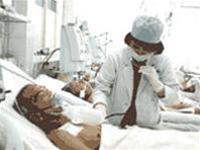Who is at risk of heart attack?
People in the group below are more likely to have a heart attack: a family member has ischemia
 Visit a patient with a myocardial infarction who has just been rescued through the danger at the intensive care unit, BV 115 (Photo: TTO) heart; smoking a lot; disorders of blood fat metabolism; suffering from hypertension, diabetes, obesity; physical inactivity; living in a stress-free environment.
Visit a patient with a myocardial infarction who has just been rescued through the danger at the intensive care unit, BV 115 (Photo: TTO) heart; smoking a lot; disorders of blood fat metabolism; suffering from hypertension, diabetes, obesity; physical inactivity; living in a stress-free environment.
The most recognizable sign of myocardial ischemia is angina pectoris with the following characteristics: often occurring after exertion, heavy work, strong emotions, after a feasting party, when the weather is too cold; feeling pain in the left chest, the area before the heart, sometimes only uncomfortable; or have a heavy feeling like being pressed in the back of the sternum, this feeling spreads to the neck, jaw, left shoulder, left arm.
The pain only lasts a few seconds to a few minutes, usually not more than 5 minutes. When pain lasts more than 15-20 minutes, you must think of a heart attack.
The frequency of pain usually changes: it can be several weeks, every few months, if more severe, several times a day. At the same time with chest pain, patients feel nervous, anxious, short of breath, sweating, nausea, palpitations, dizziness.
- The risk of heart attack can be detected by new tomography techniques
- Christmas nights are prone to heart attacks
- Unemployment increases the risk of heart attack
- Pain relievers can increase your risk of heart attack by 100%
- The risk of suicide increased after a heart attack
- Dramatic matches are at risk of heart attack
- Breathing car smoke increases the risk of heart attack
- Unexpected signs of warning of 5-minute illness kill 300 people
- Taking pain medicine can make heart disease worse
- Cold weather may increase the risk of heart attack
- After a heart attack, do not live near the highway!
- What happens when a heart attack occurs?
 Green tea cleans teeth better than mouthwash?
Green tea cleans teeth better than mouthwash? Death kiss: This is why you should not let anyone kiss your baby's lips
Death kiss: This is why you should not let anyone kiss your baby's lips What is salmonellosis?
What is salmonellosis? Caution should be exercised when using aloe vera through eating and drinking
Caution should be exercised when using aloe vera through eating and drinking